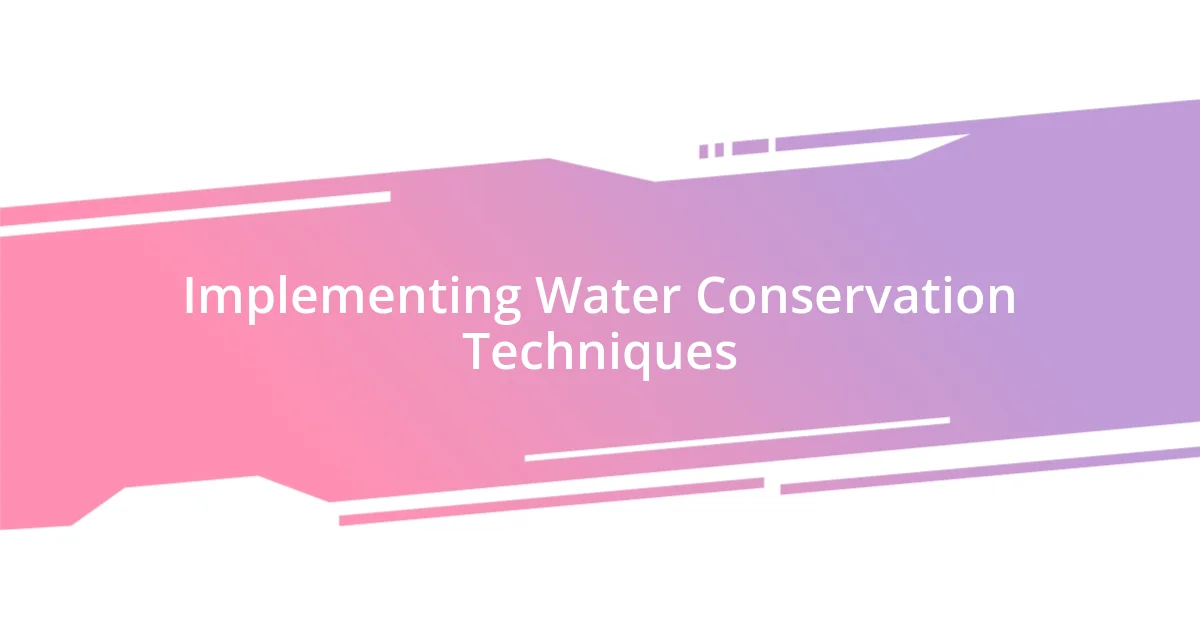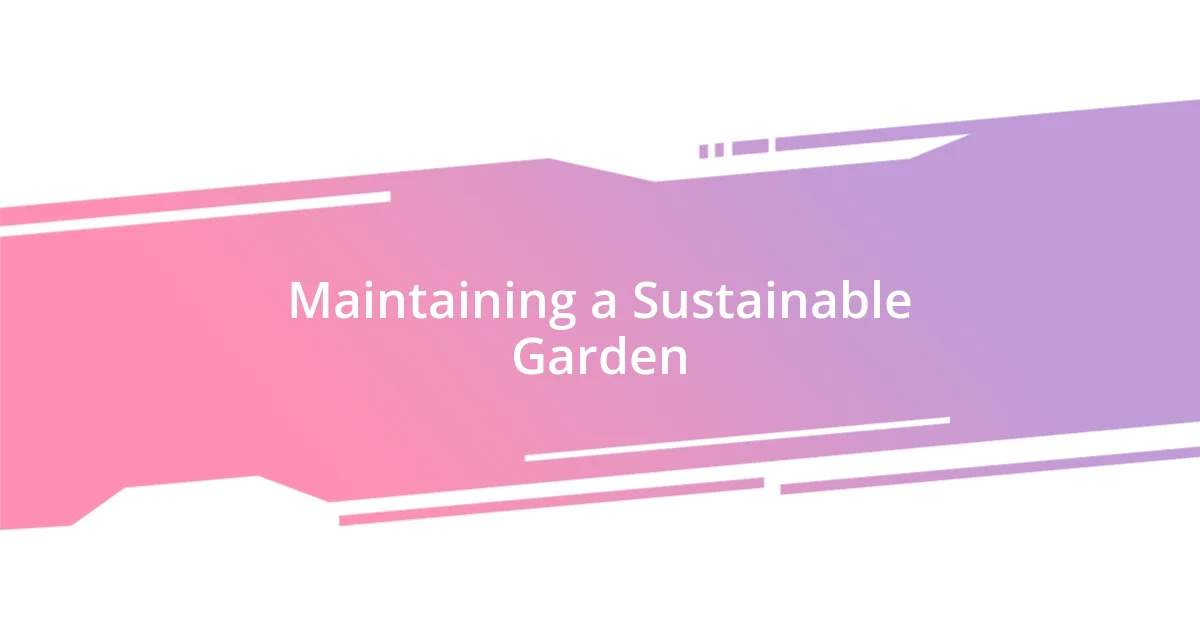Key takeaways:
- Transitioning to organic compost and mulching revitalized soil health and enhanced plant growth.
- Implementing water conservation methods, such as rainwater harvesting and drip irrigation, improved resource efficiency and plant vitality.
- Encouraging beneficial insects through native plantings and allowing wild areas promoted a thriving garden ecosystem.

Understanding Sustainable Gardening Principles
Sustainable gardening revolves around the idea of working with nature rather than against it. I remember the excitement I felt the first time I planted a small pollinator garden. Watching bees and butterflies flit around brought home the importance of attracting beneficial insects, something that genuinely transformed my understanding of the ecosystem within my garden.
One of the core principles is maintaining soil health. I once made the mistake of using chemical fertilizers, thinking it would boost my plants. Instead, I faced a cascade of issues. The soil lost its vibrancy, and the plants struggled. After switching to organic compost and mulching, not only did the plants thrive, but I felt a renewed connection to the earth, almost like learning to speak a new language of growth.
Water conservation is another vital aspect. Have you ever stood in your garden during a hot summer, watching your plants wilt? It was a wake-up call for me. I implemented rainwater harvesting systems, and now, every droplet feels cherished. These changes have not only reduced my water bill but also deepened my appreciation for nature’s resources, reminding me of our responsibility within the beautiful cycle of life.

Assessing Your Garden’s Environment
It’s essential to recognize the characteristics of your garden’s environment before diving into sustainable gardening practices. I remember the moment I decided to take a closer look at my yard. Observing sunlight patterns, wind directions, and even the types of plants thriving or struggling informed my decisions. Every little detail became a clue to creating a flourishing ecosystem.
Here’s a checklist to help you assess your garden’s environment:
- Sunlight Exposure: Are your garden areas mostly shaded or full sun?
- Soil Type: Is your soil sandy, clay-like, or loamy? Each type has different water retention characteristics.
- Microclimates: Are there warmer spots near walls or cooler areas under trees?
- Local Wildlife: What animals or insects visit frequently? Their presence can indicate the health of your garden.
- Drainage Patterns: Does water pool in certain areas after rain? This could lead to future problems like root rot.
By understanding these factors, you’ll be better equipped to cultivate a space that not only thrives but also enhances your connection to nature. My own garden’s transformation began with these simple observations, leading me to nurturing changes that felt both rewarding and necessary. Each discovery was like unlocking a door to a more vibrant, sustainable world right in my backyard.

Choosing Native and Hardy Plants
When selecting plants for my garden, I quickly learned the value of choosing natives and hardy varieties. The first time I planted some local wildflowers, their resilience amazed me. These plants flourished without much assistance from me, thriving in the local climate and attracting a variety of pollinators. It made me realize that nature knows best, and I needed to align my gardening efforts with the plants that are naturally suited to my area.
I also discovered the joy of experimenting with hardy plants. Last spring, I decided to plant some tough perennials that can withstand drought and cold. Despite facing unexpected frosts and dry stretches, they bounced back! That experience really opened my eyes to the idea of using low-maintenance plants—it’s both practical and a source of continuous delight as they surprise me with their resilience and beauty.
Here’s a comparison table illustrating some native versus non-native plant options for sustainable gardening:
| Native Plants | Non-Native Plants |
|---|---|
| Black-eyed Susan | Petunia |
| Purple Coneflower | Begonia |
| Butterfly Milkweed | Pansy |
| Wild Bergamot | Marigold |

Implementing Water Conservation Techniques
As I embarked on my journey toward a sustainable garden, implementing water conservation techniques became one of my most rewarding challenges. I recall the first time I installed a rain barrel. Watching the water collect from my roof felt magical and practical at once. It made me realize how much I could capture from nature, reducing reliance on the tap and giving me a sense of accomplishment.
Drip irrigation systems also played a significant role in my approach. I remember feeling a wave of relief the first time I set it up; it delivered moisture directly to the roots of my plants, minimizing evaporation. I wondered why I hadn’t done it sooner! This not only saved water but also made my garden care more efficient, freeing up my time for other projects—like adding more plants!
Another technique I found invaluable was mulching around my plants. The first summer of my mulched garden, I noticed how the soil retained moisture much longer. It was exhilarating to see my plants thriving, even during a heatwave. This experience taught me that small changes could lead to significant benefits. Isn’t it amazing how addressing water conservation makes an immediate impact on the health of your garden?

Creating Compost for Soil Health
Creating compost has been a game-changer for my garden’s soil health. I remember the first time I started my compost bin—it was like launching a mini-science project right in my backyard! Layering kitchen scraps, yard waste, and even some shredded newspaper felt oddly satisfying, and I found myself getting excited about the transformation happening inside. Have you ever felt the thrill of watching nature do its magic?
Composting not only enriched my soil but also connected me to the rhythms of nature. I’ll never forget the day I opened my bin and found that beautiful, crumbly black gold. It was such a profound moment—realizing that I had turned my kitchen waste into nutrient-rich compost. It made me reflect on how we often see trash as worthless, but here I was, creating something valuable. Using that homemade compost felt like giving back to the earth, and the plants thrived like never before.
I also learned about the importance of a balanced compost mix. Initially, I didn’t pay much attention to ratios, and let me tell you, I ended up with a smelly mess! Once I understood the ideal carbon-to-nitrogen ratio—about 30 parts carbon to 1 part nitrogen—it truly revolutionized my composting process. Does your compost smell funky sometimes? It’s often a sign that adjustments are needed! Keeping that balance not only keeps the smell in check but also speeds up the decomposition, turning my scraps into loveliness much faster.

Encouraging Beneficial Insects
Encouraging beneficial insects in my garden has been one of my most enjoyable endeavors. I vividly remember the first time I spotted a ladybug on one of my plants; it felt like a small victory! I had always considered insects a nuisance, but learning to appreciate these helpful creatures transformed my perspective. Have you ever watched a pollinator dance from flower to flower? It’s mesmerizing and truly highlights the delicate balance of our ecosystem.
I’ve found that planting a variety of native flowers attracts a host of beneficial insects. One summer, I decided to create a dedicated pollinator patch filled with black-eyed Susans, coneflowers, and asters. The moment those blooms opened, they were swarming with bees and butterflies. The joy of witnessing all that life bustling around was palpable. It took a bit of patience, but seeing those insects flourishing gave me a sense of pride and fulfillment. Isn’t it amazing how simple choices can create vibrant life in our gardens?
Additionally, I started leaving a few areas of my garden a bit wild, letting dandelions and clovers grow. At first, it felt counterintuitive; weren’t those weeds? But soon enough, I noticed how many beneficial insects were drawn to those untamed spots. The vibrant energy of those areas became a sanctuary for pollinators and predators alike. It was eye-opening to see that embracing a little chaos could yield such positive outcomes.

Maintaining a Sustainable Garden
Maintaining a sustainable garden has taught me the value of observation and patience. I remember the first time I tried organic pest control; instead of rushing to the store for harsh chemicals, I harnessed the power of neem oil, derived from the seeds of the neem tree. As I mixed it up, there was a moment when I thought, “Could this really work?” Watching it gradually decrease the aphid population felt rewarding, as if I’d outsmarted the pests without compromising the ecosystem.
Watering efficiently is another key aspect I’ve embraced. I started using a drip irrigation system, which not only conserves water but also delivers moisture directly to the roots. Initially, I worried if I was doing it right—wasn’t overhead watering easier? Then I realized how much healthier my plants looked, thriving in the precise conditions they needed. Have you ever watched your garden flourish due to a small change? It’s an exhilarating feeling.
Finally, embracing seasonal planting has become an essential practice for me. I recall the first time I planted cover crops during the off-season, feeling a sense of anxiety as I committed to the idea. But when spring arrived and revealed enriched soil, I was ecstatic. The benefits were clear; my garden seemed to buzz with vitality. Isn’t it fascinating how nature rewards our efforts when we align with its rhythms? Each newfound method reinforces my belief that maintaining a sustainable garden is a journey worth taking.














